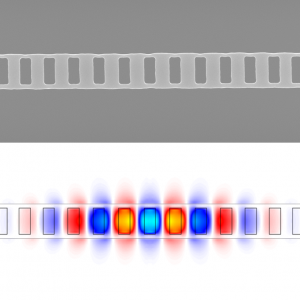Efficient optical coupling of single carbon nanotubes to photonic crystals An important step towards nanoscale photonic devices

A University of Tokyo research group led by Associate Professor Yuichiro Kato at the Graduate School of Engineering and Professor Yasuhiko Arakawa at the Institute of Industrial Science succeeded in achieving optical coupling efficiency of over 85% for individual carbon nanotube emitters coupled to photonic crystal structures.

An electron micrograph of a specially-designed photonic crystal cavity (top) and a computer simulation of optical field distribution (bottom). Unconventional modulation of hole periodicity allows for intense fields in the air holes.
© 2014 Yuichiro Kato.
Single-walled carbon nanotubes are known to be bright emitters in the telecommunication wavelength that can be grown directly on silicon, making them attractive for applications in nanoscale photonic devices. In particular, air-suspended carbon nanotubes show excellent emission properties, but efficiency of their optical coupling to photonic structures has remained low.
The research group has drastically improved the coupling efficiency by utilizing a specially designed photonic crystal structure. In contrast to conventional structures which confine light within the silicon material, the new design allows light from carbon nanotubes to fill air holes, enhancing the optical interaction with air-suspended carbon nanotubes and greatly increasing the propagation of light into the optical resonator. This technique may see applications in nanoscale photonic devices such as lasers using atomic layer materials and are an important step towards miniaturization of optical circuits and development of nanoscale photonic devices with new functionalities.
Paper
R. Miura, S. Imamura, R. Ohta, A. Ishii, X. Liu, T. Shimada, S. Iwamoto, Y. Arakawa, Y. K. Kato,
“Ultralow mode-volume photonic crystal nanobeam cavities for high-efficiency coupling to individual carbon nanotube emitters”,
Nature Communications Online Edition: 2014/11/25 (Japan time), doi: 10.1038/ncomms6580.
Article link (Publication, UTokyo Repository)
Links
Graduate School of Engineering
Institute of Engineering Innovation, Graduate School of Engineering
Kato Group, Institute of Engineering Innovation, Graduate School of Engineering







